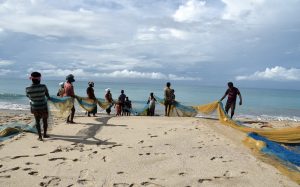Dhanushkodi, at the southernmost tip of India, is a uniquely beautiful coastal strip flanked on one side by the Bay of Bengal and on the other by the Indian Ocean. At the confluence of two seas, the marine life in the area is plentiful; it is home to exotic varieties of fish, crabs, and lobsters. Dhanushkodi was developed as a port town in the early decades of the 20th century and quickly became a bustling hub of fishermen, travellers, and pilgrims.
On the fateful night of December 22, 1964, a massive cyclonic storm wiped off Dhanushkodi from the map, destroying the buildings and railway tracks and killing 1800 people. The town was abandoned and forgotten, except for a handful of cyclone survivors – the local fisherfolk who refused to leave the place they knew as their home.
As a derelict and forgotten town, Dhanushkodi was deprived of basic human necessities like electricity, schools, a proper road system, medical infrastructure, and more. But the fisherfolk held on with unflinching courage and resilience.
In 2019, a tar road was built to connect Dhanushkodi with the nearest town of Rameshwaram, 20 kilometers away. The raw, uncluttered beauty of the powdery-white beaches was slowly attracting tourists. Based on the tourism potential of the area, the 300-odd inhabitants enjoyed a fresh dose of hope after having lived on the edge for more than half a century. However, the pandemic situation in India has stopped all tourist activities and sent the fisherfolk back into the throes of uncertainty.
Sugato Mukherjee is a photographer and writer based in Calcutta and his works have appeared in The Globe and Mail, Al Jazeera, National Geographic Traveler, Harper Collins and Yale University Journal. His coffee table book on Ladakh was published from Delhi in 2013. Some of his visuals and stories can be found at sugatomukherjee.com













































